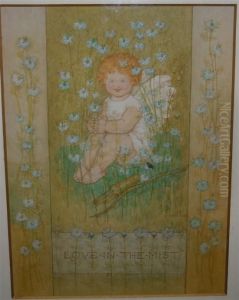Amelia M. Bauerle Paintings
Amelia Matilda Bauerle, known as Amelia M. Bauerle, was an English painter, illustrator, and etcher whose work gained recognition at the turn of the 20th century. Born in 1873 in Stoke-on-Trent, Staffordshire, England, she was the daughter of a German immigrant, Carl Bauerle, who was a successful manufacturer of porcelain. This artistic environment in her early life likely influenced her path towards a career in the arts. Amelia pursued her education at the Royal College of Art in London, where she honed her skills in painting and illustration under the guidance of esteemed instructors.
Bauerle's career is noted for its versatility, encompassing book illustrations, portraits, and genre paintings. She was particularly admired for her illustrations, which often featured in prominent publications of the day, including 'The Yellow Book,' an influential British literary quarterly. Her illustrations were characterized by their delicate and detailed style, often depicting scenes of women in graceful, contemplative poses, which reflected the Art Nouveau influences of the period. Besides her contributions to 'The Yellow Book,' Bauerle's work appeared in other periodicals and books, showcasing her ability to captivate audiences with her visual storytelling.
Amidst her accomplishments, Amelia M. Bauerle also exhibited her work in prestigious venues, including the Royal Academy of Arts in London. Her artistic output, however, was not limited to illustration. She produced a number of etchings and paintings, demonstrating her versatility as an artist. Despite her considerable talent and the recognition she received during her lifetime, Bauerle's name is not as widely known today as some of her contemporaries. Her death in 1916, at the relatively young age of 43, cut short a promising career, leaving behind a body of work that, while limited, continues to be appreciated by art historians and collectors for its beauty and finesse. Bauerle's contributions to the arts are a testament to her skill and creativity, marking her as a noteworthy figure in the landscape of early 20th-century British art.
